BLOG
How to Perfect the Post-Purchase Experience
Published: Nov 4, 2016
Can you really increase revenue by optimizing the post-purchase experience? We have, and we’ll show you how.
Months of planning, weeks of hard work and days spent biting your fingernails. All to make your new streamlined, customer-centric purchase journey a reality. You’ve followed the guides, listened to expert opinion and created a more efficient purchase journey. One which seamlessly ushers your prospects down the purchase path until they’re ready to click the big button saying “buy”.
Your hard work pays off and you see a healthy uplift in conversions. Success!
You’re now the proud owner of an effective sales funnel. All that’s left is to continue driving traffic to the top of your funnel; then it’s sit back and watch as they glide through to become paying customers. Sound a little too good to be true? That’s because it is.
You know it’s not that easy. A streamlined purchase journey is an integral part of any online brand. But it’s not the beginning and end of your marketing campaigns. Sure, optimising the purchase journey will help a higher percentage of consumers complete a purchase, but smart brands understand that the real money making opportunities come after a consumer has clicked buy.
It might sound a little weird, but the truth is smart brands can earn more and cut costs by optimising the post-purchase experience.
Why post-purchase experience is important
The post purchase experience is usually talked about in terms of customer service.
How poor after sales care leads to bad reviews and negative social proof. It’s an important element of customer interaction and highlighting your brand as one who cares about their consumer base.
But that post-purchase window can be about so much more than customer interaction and positive experiences. When well optimised you can use good customer relationships to increase average order value, solicit repeat business, and reduce outgoing costs.
- 7 times more expensive to attract new business than retain current customers (source)
- Increasing retention rates by 5% increases profits by 25% – 95% (source)
- The probability of a sale from a new customer is 5-20%, but from existing customers, it’s 60%-70% (source)
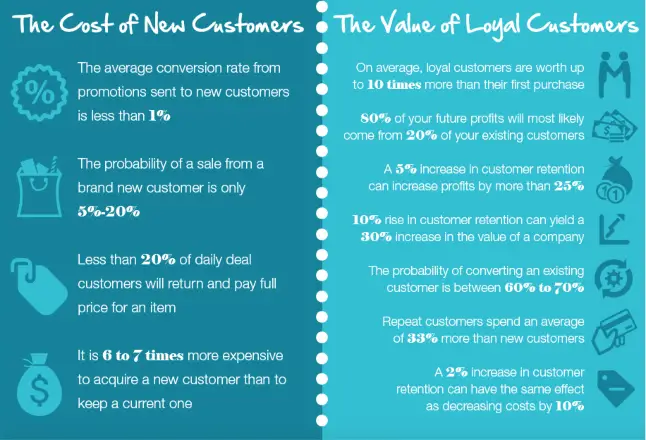
That initial conversion that turns a browser into a customer is not your end goal. Yes, it is the end of the purchase journey, but it’s also the start of the customer journey.
When someone clicks that big purchase button they’re no longer a stranger to you and your brand. They’re part of your tribe. The tribe that pays your bills, keeps a roof over your head and ensures the lights stay on. And you need to reciprocate.
You’ve got to listen to customer feedback and optimise your processes so you’re treating them with the same respect they’re offering to you. Create a well-optimised post-purchase experience for customers and they’ll not only purchase from you again, but you’ll be able to cut costs on attracting new business.
Post-purchase service
Purchasing is simultaneously the final step as a prospect and the first step as a customer. It’s here that perception shifts. You no longer have a prospect searching for a solution to a problem, you now have a consumer who needs to understand how to get the most value out of your brand and its products.
You’ve got to foster customer loyalty, and the best way to do that is to show them you care. Help them get the most out of their purchase, listen to what they have to say and show them you can be trusted.
Fostering customer loyalty is a long-term strategy. It’s rare for brands to turn first time buyers into fervent fans overnight. However, the sooner you start, the quicker you’ll see results.
- 74.4% of users expect a welcome email (source)
- Welcome emails have 320% more revenue per email than other promotional emails (source)
- 48 hours after initial conversion is the optimal time to initiate a positive customer interaction.
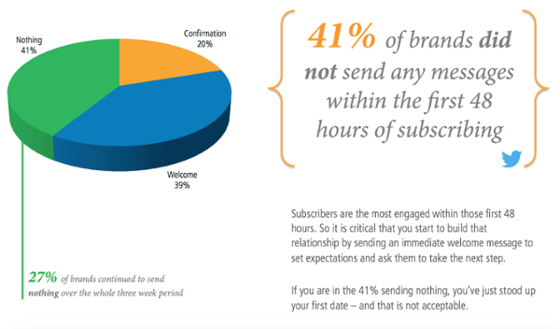
The majority of the 59% of brands who do focus on a post-purchase experience do so with a single confirmation email. It’s often very dry and generic, listing only the price, description of the product, and maybe a delivery estimate.
It’s key information the customer needs to know, but it’s hardly offering real, tangible value.
You have to go above and beyond with your customer communications. Think about the primary questions a consumer has and the fears they experience after purchasing. Then, use a post-purchase email to allay those fears.
The fears you address will be individual to your business but as an example, you’ll want to think about:
- Delivery times
- How to change delivery times if the one listed isn’t convenient
- Your returns policy
- Explicitly stating when a free trial ends
- Link to an FAQ section on site
- Identify the biggest fears and questions your consumers have and immediately solve them.
Domino’s has a great example of this. They allow delivery customers to track their order. You know its exact position in the production queue giving an indication of delivery time. A godsend when hungry or hosting a party and waiting for food.

Your post-purchase service doesn’t have to be complicated. It can be incredibly simple, but it has to address a major concern of your customers.
Post-purchase conversions
The psychological principle of successive approximations states that after a person has taken one action, they’re more likely to perform additional actions. After completing an initial conversion, users are more likely to respond to a subsequent offer. Something which you can use to grow your brand in other ways.
For instance, if you’re initial conversion solicits a list sign-up then consider implementing the below on your thank you page:
- A follow us on social media link
- Sign up to loyalty program button
- Or request more information to help better segment your audience
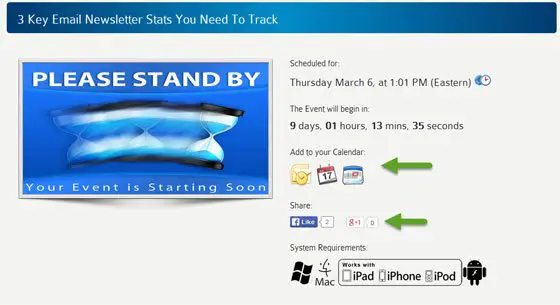
In the above example, Aweber has not only added social share buttons but also provided extra value by allowing you to add the date and time of the webinar to your calendar ensuring you don’t miss it. If a user has just purchased a product, then you might want to experiment with the following in post-purchase emails or thank you pages:
- A cross-sell recommendation
- An upsell page highlighting benefits of doing so
- Discount on secondary purchase to bring them back on site and elicit a repeat purchase
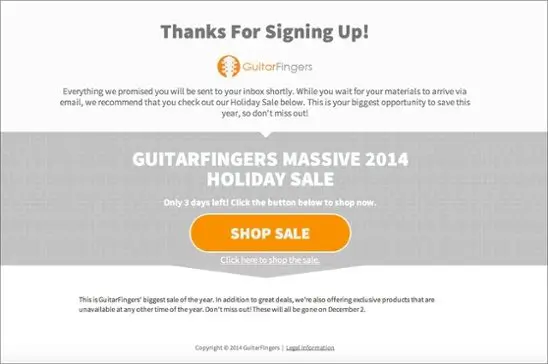
Leadpages offer this example for a thank you page that informs the user of an upcoming sale with the aim of bringing them back to the store. Successive approximations can be a great way to increase revenue and offer a better service to your consumers.
Offer targeted help
There’s nothing worse than getting a brand new product only to find you have no idea how it works. Sure, you could work your way through the dry, boring technical manual that ships with the product, but who reads those anymore?
Make understanding how to get the most out of your product easy for your consumers. Time a post-purchase email campaign so they receive key information on basic features, advanced functions and general usage tips at the time they’re most likely to need them. The below is an example post conversion email series that focuses on providing the consumer with information to get the most out of the product before soliciting a cross-sell and social proof review:

Gather new info
Your marketing campaign is only as good as the information driving action. If you know nothing about your audience then you can’t help them. The more information you have, the more targeted your campaigns and relevant your communications. Gather customer feedback during the post-purchase experience to understand more about who you’re targeting. You can do this either on the thank you page or through an automated post-purchase email.
The key is to act fast and make the most of the successive approximations. Floppi offers a great example, immediately after submitting an email you’re presented with the below box to let them know exactly what was that drove you to sign up.
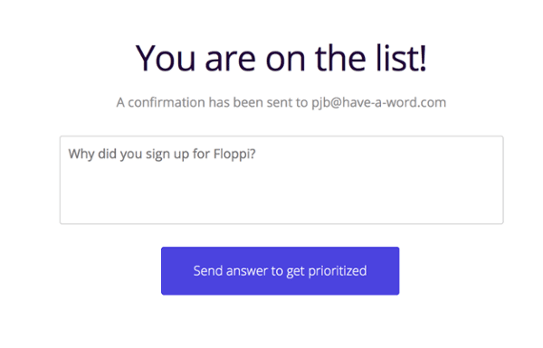
Obtain extra social proof
Consumers will always trust their peers more than you. You stand to gain from their purchase so all your claims to greatness will be met with a healthy deal of scepticism.
However, claims made by other customers are generally believed, to be honest, and true.
It will benefit you to optimise your post-purchase experience to gain as much positive social proof as possible. Derek Halpern of Social Triggers is a master of social media and has a great example of how to gather great social proof immediately after a conversion.
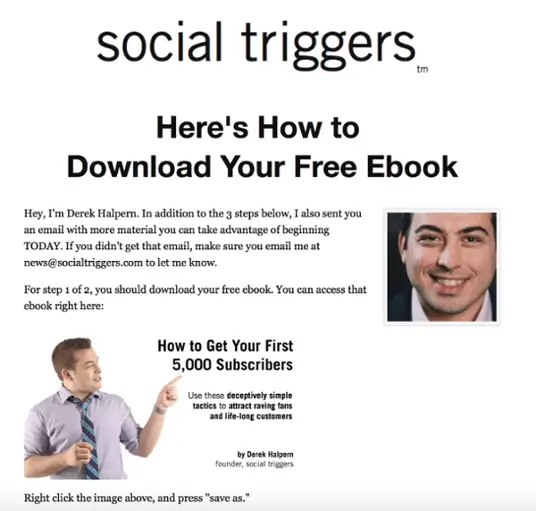
Derek begins by giving you the lead magnet you requested. However, just after he’s given you something for free, he asks for something in return.
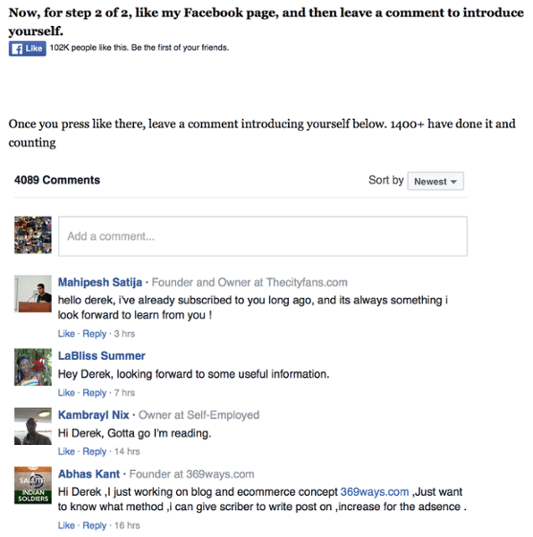
Asking for a social like, share and comment after giving you your free eBook plays on both successive approximations and the idea of reciprocity. Both great at driving customer interaction. Users will likely feel obliged to help as Derek is offering them something for free and clicking a like button is a very small conversion compared to submitting an email address.
A sale is not the finish line
Just because a customer has clicked buy, it doesn’t mean your relationship with them is finishing. In many ways, it’s just beginning. Those who have helped you out by clicking purchase are the people you need to focus your attention on. They’re the people who come back and spend more on your brand. Optimize your post-purchase experience to focus on providing a better service to those who have purchased and you’ll not only see them spending more, you’ll also attract others just like them.
Post Purchase FAQs
Once a customer has purchased your product or service they enter the post purchase phase. This presents you with a chance to build customer loyalty and build a positive impression. Send them a personalized thank you email, ask them how you can improve or if they will leave a review.
Post-purchase evaluation is important because it offers you the chance to get feedback on your products or service. Ultimately this feedback can be used to improve your customer experience by highlighting areas you are underperforming and not meeting customer expectations.
Post-purchase dissonance occurs when a customer is unsatisfied with a product or service they have purchased. There are many causes for this such as, unrealistic expectations, buyers’ remorse, poor quality product, poor service levels, bad customer service are but a few.